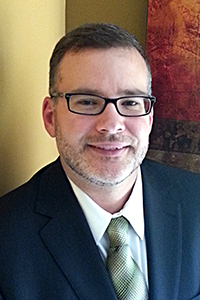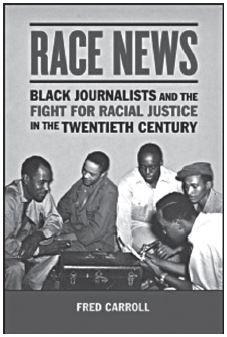February marks Black History Month, when Americans remember the heroic Crispus Attucks and George Washington Carver, daring women such as Harriett Tubman and Rosa Parks, and stalwart figures ranging from Frederick Douglass to Peoria’s own Dr. Romeo B. Garrett.
Less recognized are African Americans such as Robert Abbott, the man who founded the Chicago Defender newspaper, and Marvel Cooke, the investigative reporter who exposed the “Bronx Slave Market” where black housekeepers were virtually in bondage as day laborers.

Fred Carroll
Such journalists and the struggles they confronted, plus competitive and often contentious relationships between publications and also between journalists and activists, form the focus of a new book, “Race News: Black Journalists and the Fight for Racial Justice,” by Peoria-area native Fred Carroll.
Although the chronicle took Carroll eight years to complete, the fresh history seems close to present circumstances, one bridging the timeless and timely.
“Today, the label ‘fake news’ is hurled at credible media institutions for the purpose of partisan politicking as readily as it is used to identify propaganda intended to subvert American democracy,” says Carroll, 46. “ ‘Race News’ illustrates the limits of the doctrine of objectivity, which often serves to reinforce the status quo. But it also shows how we can avoid today’s sterile, both-sides-do-this political coverage by tempering objectivity with a moral perspective that seeks to uphold America’s highest ideals of equality for all.”
Reflecting on the background that led to his most recent work, Carroll – a 1989 graduate of Brimfield High School in western Peoria County – says, “The first time I remember looking forward to school was when we studied the European explorers in Mr. Davis’ fifth-grade class at Brimfield Grade School. The journeys of men like Hernando de Soto and Samuel de Champlain amazed me. History was my favorite subject after that.”
After earning degrees at Illinois Central College, Northern Illinois University, and the College of William and Mary, Carroll for 10 years worked in newspapers in Elmhurst, Ill., Gastonia, N.C., and Newport News, Va.
“I initially started to study black history to become a better journalist,” Carroll says. “When I was a reporter in the South, I often found that African Americans of the Civil Rights generation would hesitate to speak to me even if they knew me to be an honest journalist. They might trust me, but they did not trust the local newspaper as an institution. Such interactions made me realize how little I really knew about race and racism in America.”
Leaving newsrooms for classrooms, Carroll – who’s taught at Norfolk State, Elizabeth City State and Duquesne universities, and now at Kennesaw State University – threw himself into the project.
“Scholars have written many interesting and ground-breaking books on the black press,” he says. “Those books, though, tended to focus on the lives of individual publishers or examine the federal government’s surveillance of black journalists. As a former reporter, I was more interested in how journalists’ ideas shaped news coverage. So rather than studying a particular newspaper, I attempted to explain how newswriting across the industry shifted over time. I came at the topic with an intentionally holistic approach.”
The results are fascinating.
Historical roots are shown to have led to more recent events, from back-to-Africa ideas in the early 20th century to the faith-based Civil Rights movement in the 1950s and ’60s to more assertive Black Power efforts and contemporary protests against excessive force against black Americans.
Names maybe only vaguely recalled from textbooks become flesh-and-blood characters here, people with passion and differences, alliances and rivalries.
For example, the Niagara Movement was organized in 1905 by W.E.B. Du Bois, who’d edit the publication Crisis. Although short-lived, Niagara ushered in an era of black publications “shaped by militancy, modernity and the marketplace,” Carroll writes.
The militant Du Bois, the Atlanta University professor who pressed for integration and equality, competed against the more conciliatory Booker T. Washington, president of Alabama’s Tuskegee Institute who pushed for patience, education and vocational training.
A few years later, a race riot in Springfield led to the formation of the N.A.A.C.P., and a century ago, a similarly vicious disturbance in East St. Louis unified many African-American editors to ask President Woodrow Wilson to intervene, but he didn’t. Two years later, similar attacks on blacks in Chicago caused city leaders to instead ask the black press to soften its stance.
There are surprises here.
“When I started the project, I expected to focus almost exclusively on national and regional commercial newspapers – profit-oriented businesses that sought to reach the largest possible readership with objective news written from a black perspective,” Carroll says. “I think I made my most significant contribution to the study of black journalism by exploring the commercial black press’ contentious relationship with the alternative black press – partisan publications shaped by activists who promoted political views they believed were neglected by the ‘mainstream’ black press. Examples include Marcus Garvey’s Negro World and the Black Panther Party’s The Black Panther. That ‘surprise’ ultimately became the book’s central narrative.”
A distinctive, hardly “alternative” publication was Ebony magazine, launched in 1945 by John Johnson to be upbeat and showcase African Americans’ “positive, everyday achievements from Harlem to Hollywood.” Black editors resented its focus on celebrity and “fluff,” Carroll writes.
Other unexpected revelations included interests that would be assumed to share ideals, such as black newspaper editors and the Newspaper Guild labor union, at odds. Also, prominent African-American authors passed through newspapers that advocated for civil rights, such as Richard Wright and Ralph Ellison, both of whom wrote for the Communist Party’s Daily Worker from time to time.
During wartime, black publications rose to the challenges. Despite financial resources limiting the assignment of black reporters to Europe (where military credentials were hard to get anyway), a few correspondents covered World War I; poet and novelist Langston Hughes was among those who covered the Spanish Civil War; and four top African-American papers sent journalists into combat zones during World War II.
When Baltimore’s Afro-American assigned Vincent Tubbs to cover the war’s Pacific Theater, his assumptions about racism changed after, en route, he saw Japanese Americans confined in U.S. concentration camps.
“The flagrant trampling of civil rights stunned him,” Carroll writes. “Tubbs realized ‘the race problem is not the colored man’s concern alone.’”
A decade later, the book recalls, black papers led coverage of now-familiar figures: the Rev. Martin Luther King Jr., Malcolm X, Eldridge Cleaver and Stokely Carmichael.
While the black press generally kept up with shifting strategies, change confused the mainstream press, recalled Carmichael, head of the Student Nonviolent Coordinating Committee, which had started pushing Black Power.
“I do remember clearly how little they [white reporters] seemed to understand, as though they were stuck in 1960 with the student sit-ins and we were speaking in unknown tongues,” Carroll quotes the black leader.

“Race News: Black Journalists and the Fight for Racial Justice,” by Fred Carroll, University of Illinois Press, 264 pages, available at booksellers including Barnes & Noble and Amazon.com.
Carroll uncovered a comment from Southern Christian Leadership Conference leader Ralph Abernathy, who noted white reporters’ geographic bias.
“When you attacked Mississippi, New Yorkers and San Franciscans felt good about themselves,” Abernathy said. “When you attacked Chicago, everybody felt uncomfortable.”
Black leader H. Rap Brown also criticized the black press that distanced itself from activists expanding their issues beyond equal rights. When radicals pushed for voter registration, supported farmworkers and opposed the Vietnam War and the draft, “Brown accused commercial black publishers of abandoning their industry’s long tradition of strident racial protest,” Carroll writes.
Whether understanding advocates of Black Power or Black Lives Matter, editorializing for non-controversial issues such as education, or covering the culture, the African-American press for decades has served countless readers and, in some 200 21st-century publications including the St. Louis American and Peoria’s Traveler Weekly, it still reaches about 20 million readers each week, according to the National Newspaper Publishers Association.

Recent Comments